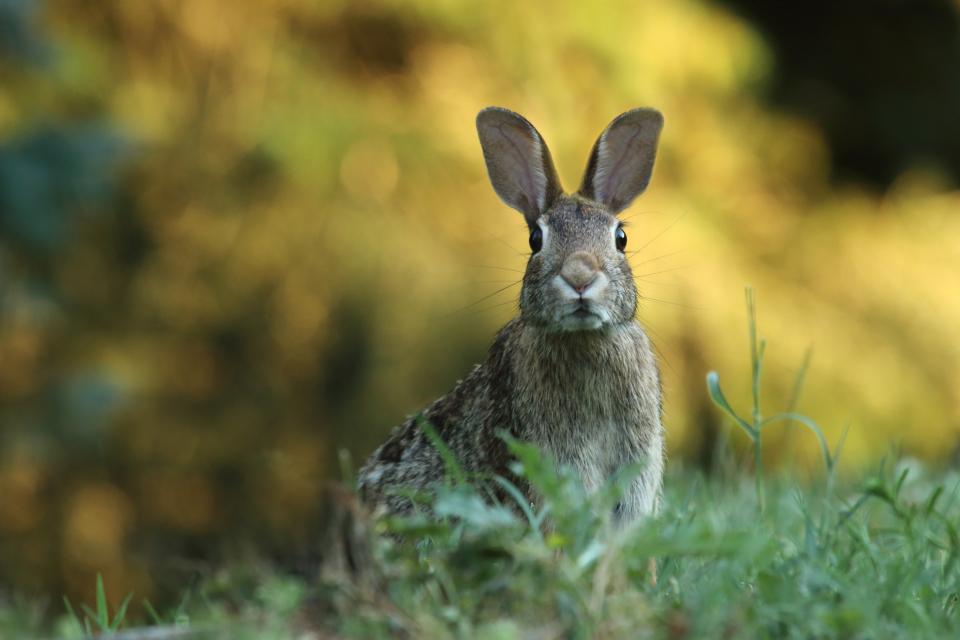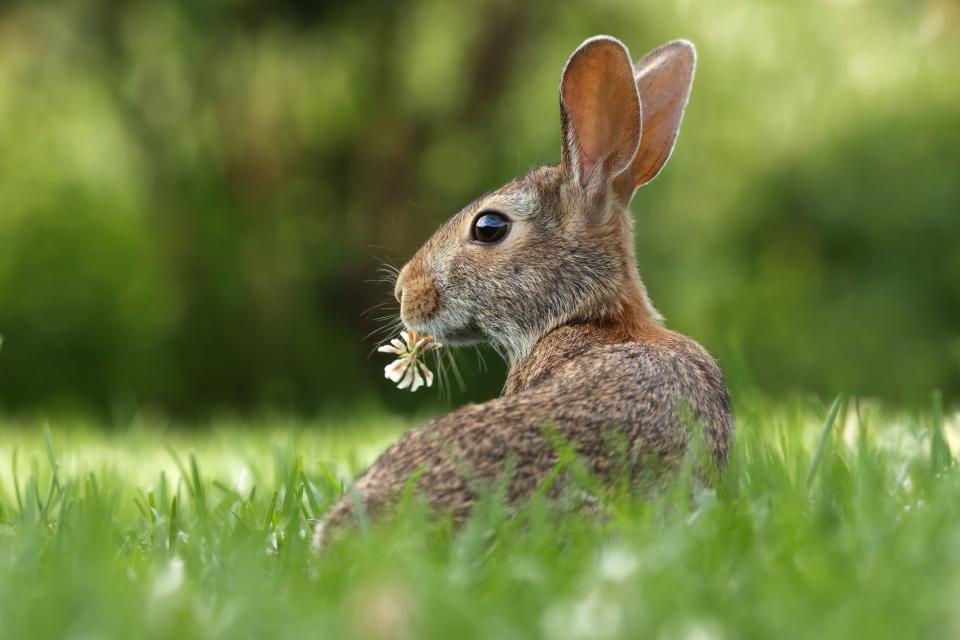This article dives deep into the fascinating world of rabbit sleep, revealing the nuances of their unique sleeping patterns, preferred resting positions, and the factors that influence their slumber. We'll explore how to provide a safe and comfortable sleep environment for your furry companion, as well as address common sleep concerns and how to identify potential problems.
Part 1: Unlocking the Secrets of Rabbit Sleep

1.1. Why Do Rabbits Sleep?
While the exact reasons for sleep are still debated in the scientific community, it is generally believed that sleep serves crucial functions in both humans and animals, including:
Rest and Repair: Sleep allows the body to repair and restore itself after a day of activity.
Energy Conservation: Sleeping conserves energy, which is vital for survival, especially for prey animals like rabbits.
Brain Function: Sleep plays a vital role in memory consolidation, learning, and emotional regulation.
1.2. Are Rabbits Nocturnal, Diurnal, or Crepuscular?
Rabbits are not strictly nocturnal, meaning they don't only sleep during the day and are active at night. Similarly, they are not diurnal, sleeping at night and active during the day. Instead, rabbits are crepuscular, exhibiting the highest levels of activity during dawn and dusk. This adaptation allows them to take advantage of cooler temperatures and reduced predator activity during these twilight hours.
1.3. How Often Do Rabbits Sleep?
A healthy adult rabbit typically sleeps for 8-9 hours a day, though this can vary based on age, health, and environmental factors. Their sleep is fragmented into numerous short naps throughout the day and night, rather than one long sleep session.
Part 2: The Curious World of Rabbit Sleeping Positions

2.1. The Classic Side Sleeper
This is the most common resting position for rabbits, with their legs tucked neatly underneath their bodies. They often lie on their sides, with their heads resting comfortably on their paws or stretched out in front of them. This position provides a sense of security and warmth, particularly when sleeping in a group.
2.2. The Snuggled-Up Curl
Rabbits often curl up into a tight ball, especially when feeling cold or vulnerable. This position helps conserve body heat and minimizes their exposed surface area, making them less noticeable to potential predators.
2.3. The Upright Sleeper
While less common, rabbits can occasionally sleep while standing, particularly in a secure environment. They may rest their weight against a wall or a sturdy object, ensuring stability while taking a brief nap.
2.4. The Open-Eye Mystery
Rabbits have a unique eye structure that allows them to sleep with one eye open! This remarkable adaptation is a survival mechanism for prey animals, enabling them to remain partially alert even while resting.
Part 3: Understanding What Influences Rabbit Sleep
3.1. Age and Sleep
As with many mammals, young rabbits, known as kits, sleep significantly more than their adult counterparts. This increased sleep duration is crucial for their rapid growth and development. As rabbits mature, their sleep needs gradually decrease.
3.2. Health and Wellbeing
A rabbit's health status plays a significant role in its sleep patterns. Illness, pain, or discomfort can disrupt sleep, leading to changes in sleeping habits, such as increased daytime sleep or restlessness.
3.3. Environmental Factors
A rabbit's environment significantly impacts its ability to sleep well. Noise, light, and temperature can all interfere with restful sleep.
Noise: Loud noises, especially sudden ones, can startle a rabbit and disrupt its sleep.
Light: Bright lights can interfere with melatonin production, the hormone responsible for regulating sleep-wake cycles.
Temperature: Rabbits are sensitive to temperature fluctuations. An overly hot or cold environment can make it difficult for them to sleep comfortably.
3.4. Social Interactions and Sleep
Rabbits are social animals and often sleep in close proximity to each other, especially within a group. This behavior provides comfort, warmth, and a sense of security. However, if a rabbit is experiencing conflict or stress within its social group, it may experience sleep disturbances.
Part 4: Creating a Sanctuary for Sleep
4.1. The Importance of a Secure Sleep Space
As prey animals, rabbits instinctively seek safe and concealed areas to sleep. A secure sleep space provides a sense of protection and allows them to relax and sleep soundly without feeling vulnerable.
4.2. Designing a Cozy Sleep Nest
To create an ideal sleep environment for your rabbit, consider the following factors:
Soft Bedding: Provide ample soft bedding, such as hay, straw, or fleece, to create a comfortable sleep space. These materials also absorb moisture and help regulate temperature.
Hideaways: Rabbits often prefer to sleep in enclosed areas, such as a cardboard box, a burrow-like structure, or a rabbit hutch with a hideaway. These provide a sense of security and privacy.
Temperature Control: Rabbits are sensitive to temperature changes, so ensure their sleep space is neither too hot nor too cold. A comfortable temperature range is typically between 60-75 degrees Fahrenheit (15-24 degrees Celsius).
4.3. Encouraging Restful Sleep
Regular Routine: Establishing a consistent feeding and play schedule helps regulate your rabbit's sleep-wake cycle. This provides a sense of predictability and promotes a healthy sleep rhythm.
Exercise: Adequate exercise during the day can help tire out your rabbit and promote restful sleep at night.
Avoid Over-Stimulation: Limit loud noises and bright lights, especially in the evening, to encourage relaxation.
Part 5: Recognizing When Sleep May Be a Problem
5.1. Changes in Sleeping Habits
Increased daytime sleep: Excessive daytime sleeping could indicate illness, pain, or stress.
Restlessness: If your rabbit is constantly moving or seems agitated, it could be a sign of discomfort or a sleep problem.
Nighttime activity: An unusually active rabbit at night might suggest a disruption in its sleep cycle.
5.2. Other Signs to Watch For
Loss of appetite: A decrease in appetite can be a symptom of various health issues, including sleep problems.
Weight loss: Unexplained weight loss can be a sign of a sleep disorder or a more serious underlying health condition.
Lethargy: A rabbit that is sluggish and inactive may be suffering from a lack of sleep.
Part 6: Addressing Sleep Issues
6.1. The Importance of a Veterinary Check-Up
Rule Out Medical Conditions: It's crucial to rule out any underlying health problems that could be affecting your rabbit's sleep.
Tailored Treatment: Your vet can provide appropriate treatment for any diagnosed medical conditions.
6.2. Environmental Adjustments
Minimize Noise: Ensure your rabbit's sleep space is quiet and undisturbed by loud noises.
Control Light: Keep the light levels low in the evening to signal bedtime. Use blackout curtains or a nightlight to create a calming atmosphere.
Temperature Regulation: Adjust the temperature of your rabbit's sleeping area to maintain a comfortable environment.
6.3. Behavioral Interventions
Exercise: Regular exercise can help your rabbit tire out and sleep better. Provide a variety of safe toys and activities to encourage physical activity.
Enrichment: Provide toys and other enrichment items to keep your rabbit mentally stimulated. This can include puzzle feeders, tunnels, digging boxes, and hiding places.
Socialization: If your rabbit is lonely, consider adding another rabbit to its environment, provided they are compatible.
Part 7: Understanding Rabbit Sleep Cycles
7.1. REM Sleep in Rabbits
Like humans, rabbits experience both REM (Rapid Eye Movement) sleep and non-REM sleep. During REM sleep, a rabbit's eyes may twitch rapidly, and its muscles may become temporarily paralyzed, similar to the experience of dreaming in humans.
7.2. Non-REM Sleep
Non-REM sleep, also known as slow-wave sleep, is characterized by deeper relaxation and a slower heart rate. This stage of sleep is essential for physical restoration and repair.
7.3. Factors Affecting Sleep Cycles
The duration and frequency of REM and non-REM sleep cycles in rabbits can be influenced by various factors, including age, health, and environmental factors.
Part 8: Frequently Asked Questions
8.1. Why does my rabbit sleep with its eyes open?
Rabbits have a unique eye structure that allows them to sleep with one eye open. This is a natural adaptation for a prey animal, as it allows them to stay vigilant and detect potential threats.
8.2. How much sleep do baby rabbits need?
Baby rabbits, also known as kits, sleep for longer periods than adult rabbits, often 10-12 hours a day. Their sleep needs gradually decrease as they mature.
8.3. What should I do if my rabbit is sleeping too much?
Excessive daytime sleep can indicate illness or stress. Consult your veterinarian to rule out any medical conditions and discuss appropriate steps to improve your rabbit's sleep quality.
8.4. Is it normal for rabbits to sleep in a standing position?
Yes, rabbits can sometimes sleep while standing, especially in a secure environment. This is a less common position but perfectly normal.
8.5. How can I encourage my rabbit to sleep more at night?
Establishing a regular routine, providing adequate exercise, and creating a quiet and comfortable sleep environment can help encourage your rabbit to sleep more at night.
8.6. Is it safe to wake up my rabbit from sleep?
It's generally best to avoid waking your rabbit abruptly from sleep. It can be stressful and disruptive to their sleep cycle. If you need to move your rabbit, do so gently and quietly.
8.7. Can rabbits suffer from sleep disorders?
While sleep disorders are less common in rabbits compared to other species, they can occur. If you suspect your rabbit may have a sleep disorder, consult your veterinarian for an evaluation.
Everyone is watching
-

Do Rabbits Lay Eggs? (The Surprising Truth)
OTHER TYPES OF PETSThis article will unravel the common misconception that rabbits lay eggs, exploring the fascinating world of r...
-

What's a Group of Rabbits Called? (A Comprehensive Guide)
OTHER TYPES OF PETSThis article delves into the fascinating world of rabbits, exploring the various terms used to describe a grou...
-

Can Rabbits Eat Grapes? A Guide to Safe Rabbit Treats
OTHER TYPES OF PETSThis comprehensive guide will explore the safety and suitability of grapes for rabbits, providing detailed inf...
-

Predators That Hunt Rabbits: A Guide to Natural Enemies
OTHER TYPES OF PETSI've always been fascinated by the circle of life, that delicate dance between predator and prey. Growing up ...
-

Are Rabbits Nocturnal Animals?
OTHER TYPES OF PETSThe question of whether rabbits are nocturnal animals is a fascinating one, with a surprisingly complex answer...
